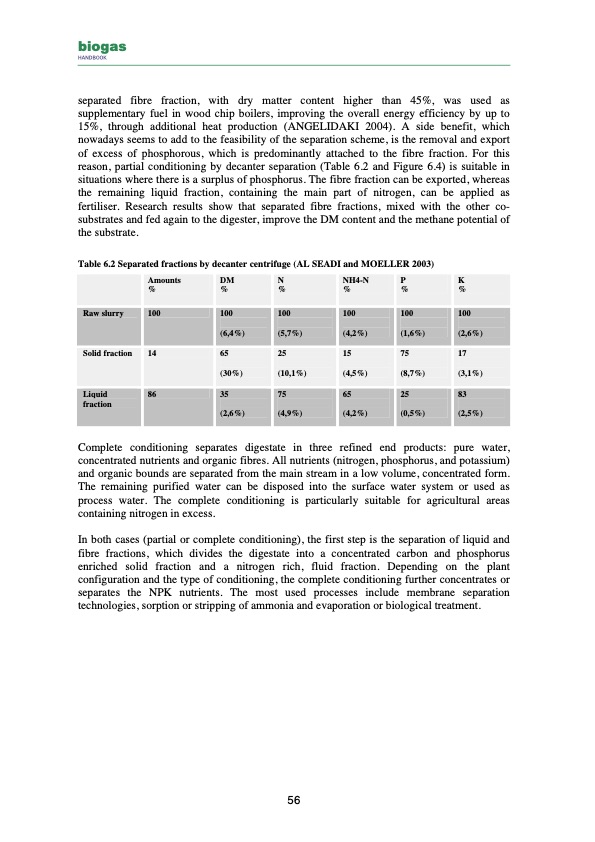
PDF Publication Title:
Text from PDF Page: 056
biogas HANDBOOK separated fibre fraction, with dry matter content higher than 45%, was used as supplementary fuel in wood chip boilers, improving the overall energy efficiency by up to 15%, through additional heat production (ANGELIDAKI 2004). A side benefit, which nowadays seems to add to the feasibility of the separation scheme, is the removal and export of excess of phosphorous, which is predominantly attached to the fibre fraction. For this reason, partial conditioning by decanter separation (Table 6.2 and Figure 6.4) is suitable in situations where there is a surplus of phosphorus. The fibre fraction can be exported, whereas the remaining liquid fraction, containing the main part of nitrogen, can be applied as fertiliser. Research results show that separated fibre fractions, mixed with the other co- substrates and fed again to the digester, improve the DM content and the methane potential of the substrate. Table 6.2 Separated fractions by decanter centrifuge (AL SEADI and MOELLER 2003) Amounts % DM % N % NH4-N % P % K % Raw slurry 100 100 (6,4%) 100 (5,7%) 100 (4,2%) 100 (1,6%) 100 (2,6%) Solid fraction 14 65 (30%) 25 (10,1%) 15 (4,5%) 75 (8,7%) 17 (3,1%) Liquid fraction 86 35 (2,6%) 75 (4,9%) 65 (4,2%) 25 (0,5%) 83 (2,5%) Complete conditioning separates digestate in three refined end products: pure water, concentrated nutrients and organic fibres. All nutrients (nitrogen, phosphorus, and potassium) and organic bounds are separated from the main stream in a low volume, concentrated form. The remaining purified water can be disposed into the surface water system or used as process water. The complete conditioning is particularly suitable for agricultural areas containing nitrogen in excess. In both cases (partial or complete conditioning), the first step is the separation of liquid and fibre fractions, which divides the digestate into a concentrated carbon and phosphorus enriched solid fraction and a nitrogen rich, fluid fraction. Depending on the plant configuration and the type of conditioning, the complete conditioning further concentrates or separates the NPK nutrients. The most used processes include membrane separation technologies, sorption or stripping of ammonia and evaporation or biological treatment. 56PDF Image | biogas HANDBOOK

PDF Search Title:
biogas HANDBOOKOriginal File Name Searched:
BiogasHandbook.pdfDIY PDF Search: Google It | Yahoo | Bing
Capstone Turbine and Microturbine: Capstone microturbines used and new surplus for sale listing More Info
Consulting and Strategy Services: Need help with Capstone Turbine, sizing systems, applications, or renewable energy strategy, we are here to assist More Info
Container Lumber Dry Kiln: Since 1991 developing and innovating dry kilns using standard shipping containers More Info
Supercritical CO2 Lumber Dry Kiln: Compact fast drying in 3 days or less for small amounts of wood and lumber drying More Info
BitCoin Mining: Bitcoin Mining and Cryptocurrency... More Info
Publications: Capstone Turbine publications for microturbine and distributed energy More Info
FileMaker Software for Renewable Energy Developing database software for the renewable energy industry More Info
CO2 Gas to Liquids On-Demand Production Cart Developing a supercritical CO2 to alcohol on-demand production system (via Nafion reverse fuel cell) More Info
Stranded Gas for low cost power Bitcoin Mining Using stranded gas for generators may provide breakthrough low power costs for cryptocurrency miners. More Info
| CONTACT TEL: 608-238-6001 Email: greg@globalmicroturbine.com | RSS | AMP |